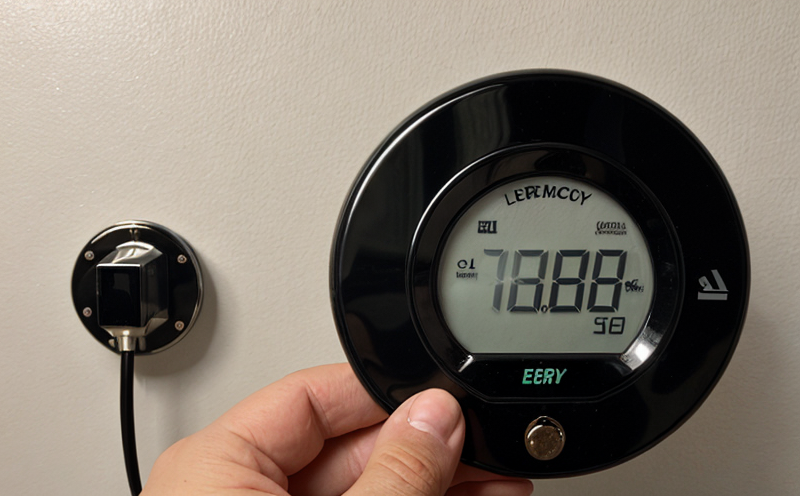ASTM F429 Energy Consumption Testing for Household Refrigerators
The testing of household refrigerators according to ASTM F429 is a crucial step in ensuring energy efficiency and compliance with international standards. This method determines the energy consumption of refrigerators over a specified operating period, providing manufacturers and regulators with critical data on how efficiently these appliances perform under real-world conditions.
ASTM F429 outlines a standardized procedure for measuring the energy consumption of household refrigerators, which helps in verifying that the appliances meet or exceed regulatory requirements. The test is particularly important as it evaluates the refrigerator's ability to maintain its temperature settings while consuming minimal electricity. This ensures not only compliance with environmental regulations but also enhances consumer satisfaction by delivering cost-effective and environmentally friendly products.
The testing process involves placing a representative sample of the refrigerator in an environment that simulates typical household conditions, including temperature fluctuations and power supply variations. The equipment used for this test is carefully calibrated to ensure accurate readings. Once the device has been running for the specified duration, energy consumption data is collected and analyzed.
Understanding the nuances of ASTM F429 testing helps stakeholders appreciate its significance in enhancing product quality and driving innovation within the sector. By adhering to these standards, manufacturers can demonstrate their commitment to sustainable practices while also offering products that meet consumer expectations for reliability and efficiency.
| Parameter | Description |
|---|---|
| Test Duration | The test typically runs continuously over 24 hours under controlled conditions to simulate a full day of operation. |
| Temperature Range | The refrigerator is operated within a range that reflects typical household temperatures, ensuring accurate energy consumption measurements. |
| Data Collection | Energy usage data is recorded at regular intervals throughout the test period to capture variations in performance over time. |
Accurate and consistent testing ensures that products are evaluated fairly and equitably, allowing for meaningful comparisons between different models. This process supports informed decision-making by consumers who can choose energy-efficient appliances based on verifiable data rather than marketing claims alone.
- Enhanced Compliance: Ensures adherence to international standards promoting sustainable practices.
- Improved Efficiency: Identifies opportunities for improving product design and functionality.
- Consumer Satisfaction: Delivers reliable, energy-efficient products that meet consumer needs effectively.
In conclusion, ASTM F429 testing is essential for maintaining high standards in household refrigerator manufacturing. It plays a vital role in promoting environmental responsibility and delivering value to consumers through efficient appliance performance.
Why Choose This Test
- Regulatory Compliance: Ensures that products meet strict energy efficiency requirements set by international standards like ASTM F429.
- Quality Assurance: Provides a standardized method for evaluating product performance, ensuring consistent results across different batches and models.
- Innovation Support: Facilitates the development of more efficient products through detailed insights into energy consumption patterns.
- Market Differentiation: Allows manufacturers to highlight their commitment to sustainability in a competitive market.
By choosing ASTM F429 testing, stakeholders can gain confidence that their products will perform reliably and efficiently, thereby enhancing brand reputation and customer trust. This testing method not only supports compliance with legal requirements but also fosters innovation by providing valuable data for continuous improvement efforts.
Customer Impact and Satisfaction
The results of ASTM F429 energy consumption tests have a direct impact on the satisfaction levels of both consumers and businesses. For consumers, efficient refrigerators translate into reduced utility costs, which can be significant over time. By choosing appliances that meet these stringent standards, they contribute to reducing their carbon footprint without sacrificing convenience or functionality.
For manufacturers and retailers, compliance with ASTM F429 testing ensures that products are marketed accurately based on verifiable performance metrics. This transparency builds trust among consumers while allowing companies to differentiate themselves in a crowded market. Moreover, it supports ongoing improvements through insights gained from comprehensive test data.
The broader implications extend beyond individual households; when many people purchase energy-efficient refrigerators, there is an overall reduction in global electricity consumption and greenhouse gas emissions. This collective effort contributes significantly towards achieving sustainability goals set forth by various organizations worldwide.
Use Cases and Application Examples
| Use Case | Description |
|---|---|
| Product Development | Determining baseline performance to guide future design iterations. |
| Compliance Verification | Ensuring adherence to regulatory requirements before product launch. |
| Quality Control | Monitoring manufacturing processes for consistency and improvement opportunities. |
The ASTM F429 test is widely used across various industries, including appliance manufacturing, energy management systems, and retail. In product development stages, it helps identify areas where improvements can be made to enhance efficiency further. During compliance verification, the test ensures that new models meet all necessary standards before they reach market shelves.
For quality control purposes, this testing method allows manufacturers to track changes in production methods or materials that might affect energy consumption levels. By regularly conducting ASTM F429 tests throughout the supply chain, companies can maintain high-quality standards and ensure consistent performance across all units produced.





